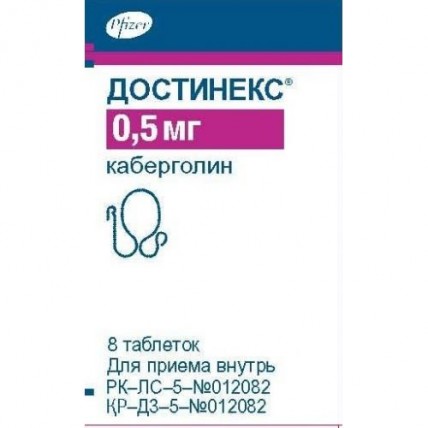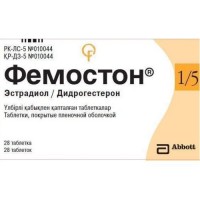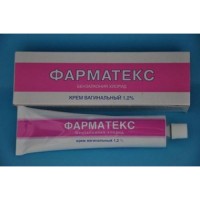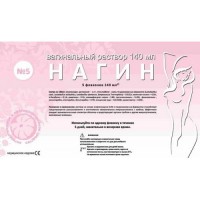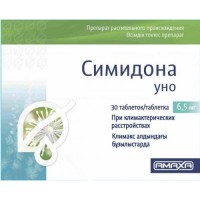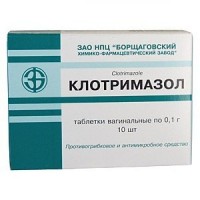Dostinex® 0.5 mg 8's tab.
- $88.00
Out Of Stock
The instruction for medical use
of DOSTINEKS medicine
the Trade name
of Dostinex
the International unlicensed
name Kabergolin Lekarstvennaya a form
of the Tablet of 0.5 mg
Structure
One tablet contains
active agent - kabergolin 0.5 mg,
excipients: anhydrous lactose, leucine.
The description
of the Tablet of oblong shape, with a flat surface of white color, with marking of P and U, with risky on the one hand and figure 700 on the other hand with short notches over and under central 0 in figure.
Pharmacotherapeutic group
Other drugs for treatment of gynecologic diseases.
Secretion prolactin inhibitors.
Kabergolin
the ATX G02CB03 Code
the Pharmacological
Pharmacokinetics Kabergolin properties is quickly soaked up from digestive tract, the maximum concentration in blood plasma is reached in 0.5 - 4 hours, communication with proteins of blood plasma makes 41 42%. The elimination half-life of a kabergolin estimated on clearance rate with urine makes 63 - 68 hours at healthy volunteers and 79 - 115 hours at patients with a giperprolaktinemiya. Owing to long elimination half-life the condition of equilibrium concentration is reached in 4 weeks. In 10 days after administration of drug in urine and Calais are found according to about 18% and 72% of the accepted dose, and the share of not changed drug in urine makes 2 3%. The key product of metabolism of a kabergolin identified in urine is 6-allyl-8-carboxy-ergolin in concentration up to 4 - 6% of the accepted dose. Content in urine of 3 additional metabolites does not exceed 3% of the accepted dose. It is established that products of metabolism have considerably smaller effect concerning suppression of secretion of prolactin in comparison with kabergoliny. Biotransformation marked was also studied by a radioactive label of a kabergolin at healthy volunteers, at the same time it was fast and considerable.
Experiments of in vitro showed what kabergolin at concentration of 0.110 ng/ml contacts proteins of blood plasma for 4142%.
Meal does not influence absorption and distribution of a kabergolin.
The pharmacodynamics
of Dostinex is to dofaminergichesky derivatives of an ergolin and is characterized by the prolaktinsnizhayushchy action caused by direct stimulation of D2 - dopamine receptors of lactotropic cells of a hypophysis. Besides, at reception of higher doses in comparison with those for decrease in level of prolactin in blood serum, Dostinex has the central dofaminergichesky effect owing to stimulation of D2retseptorov.
Decrease in concentration of prolactin in blood plasma is noted during 3 h after administration of drug and remains within 7-28 days at healthy volunteers and patients with a giperprolaktinemiya, and to 14-21 days - at women in a puerperal period.
Dostinex possesses strictly selective effect, does not influence basal secretion of other hormones of a hypophysis and cortisol. Prolaktinsnizhayushchy effect of drug is dose-dependent as concerning expressiveness, and action duration.
Only the lowering of arterial pressure (ABP) belongs to the pharmakodinamichesky influences of Dostinex which are not connected with therapeutic effect. At single dose of drug the maximum hypotensive effect is noted within the first 6 hours and is dose-dependent.
Indications
- Prevention of a physiological lactation after the delivery
- suppression of already established postnatal lactation:
a) after the delivery at unwillingness of mother to nurse or if feeding by a breast is contraindicated to mother or the child for the medical reasons,
b) after the birth of a dead fruit or abortion
- treatment of the disturbances connected with a giperprolaktinemiya including an amenorrhea, an oligomenorrhea, anovulation, a galactorrhoea
- prolaktinsekretiruyushchy adenomas of a hypophysis (micro - and makroprolaktinoma), an idiopathic giperprolaktinemiya, a syndrome of an empty Turkish saddle in combination with a giperprolaktinemiya.
Route of administration and doses
Inside, at meal time.
Prevention of a lactation: 1 mg once (2 tablets on 0.5 mg), in the first day after the delivery.
Suppression of the established lactation: on 0.25 mg (1/2 tablets) two times a day every 12 hours within two days (the general dose is equal to 1 mg). For the purpose of reduction of risk of orthostatic hypotension at the nursing mothers, the single dose of Dostinex should not exceed 0.25 mg.
Treatment of the disturbances connected with a giperprolaktinemiya: the recommended initial dose makes 0.5 mg a week in one step (1 tablet of 0.5 mg) or in two steps (on 1/2 tablets of 0.5 mg, for example, on Monday and Thursday). Increase in a week dose has to be carried out gradually on 0.5 mg with a monthly interval before achievement of optimum therapeutic effect. The therapeutic dose usually makes 1 mg a week, but can fluctuate from 0.25 to 2 mg a week. The maximum dose for patients with a giperprolaktinemiya should not exceed 4.5 mg a week.
Depending on shipping, the week dose can be accepted once or to divide into 2 and more inclusion in week. Division of a week dose into several receptions is recommended when prescribing drug in a dose more than 1 mg a week.
During selection of a dose of patients it is necessary to observe for the purpose of definition of the smallest effective dose. Prolactin level in blood serum should be determined monthly as its normalization is usually observed within 24 weeks after selection of an effective dose.
After drug withdrawal of Dostinex the giperprolaktinemiya recurrence is usually observed. However permanent reduction of level of prolactin within several months is in certain cases noted. At most of women the ovulatory cycles remain, at least, within 6 months after drug withdrawal of Dostinex.
The maximum recommended dose makes 3 mg a day.
At patients with hypersensitivity to dofaminergichesky drugs the likelihood of development of by-effects can be reduced, having begun therapy by Dostinex in lower dose (for example, on 0.25 mg once a week), with the subsequent its gradual increase up to achievement of a therapeutic dose. For improvement of tolerance of drug at emergence of the expressed by-effects perhaps temporary dose decline with the subsequent its more gradual increase (for example, increase by 0.25 mg a week each two weeks).
Duration of treatment is defined by the attending physician.
Side effects Very often (& ge, 1/10)
- a warm valvulopatiya (including valve regurgitation) and the connected disturbances (pericarditis and an exudative pericarditis)
- a headache, vertigo (dizziness)
- nausea, dyspepsia, gastritis, an abdominal pain
- an asthenia, increased fatigue
Often (& ge, 1/100 to & lt, 1/10)
- drowsiness
- a depression
- orthostatic hypotension (at prolonged use, Dostinex usually has hypotensive effect), postural hypotension, inflows
- a constipation, vomiting
- mammary gland pain
- an asymptomatic lowering of arterial pressure (systolic arterial blood pressure & ge, 20 mm Hg and diastolic arterial blood pressure & ge, 10 mm Hg.)
Infrequently (& ge, 1/1000 to & lt, 1/100)
- a cardiopalmus
- dispnoe, exudative pleurisy, fibrosis (including pulmonary fibrosis), nasal bleeding
- reactions of the increased hypersensitivity
- a tranzitorny hemianopsia, a syncope, paresthesias
- the raised libido
- an angiospasm of fingers
- hypostasis, peripheral hypostasis
- rash, an alopecia (hair loss)
- spasms of muscles of legs
- decrease in level of hemoglobin within the first several months after restoration of periods at women with an amenorrhea
Is rare (& ge, 1/10000 to & lt, 1/1000)
- pain in epigastric area
Is very rare (& lt, 1/10000)
- plevrofibroz
Does not know
- stenocardia
- disturbances from respiratory organs, respiratory insufficiency, pleurisy, thorax pain
- sudden backfilling, a tremor
- a disorder of vision
- aggression, nonsense, hyper sexuality, morbid attraction to gamblings, psychotic disturbances, hallucinations
- an abnormal liver function
- increase in level of a kreatinfosfokinaza, an aberration of biochemical indicators of function of a liver
of the Contraindication
- hypersensitivity to a kabergolin or other components of drug and also to any alkaloids of an ergot
- intolerance of a galactose
- deficiency of Lappa lactase
- glyukozo-galaktozny malabsorption
- the arterial hypertension which developed against the background of pregnancy, for example, a preeclampsia or postnatal arterial hypertension
- a heavy liver failure (use of lower doses)
- heavy psychotic or cognitive disturbances (including in the anamnesis)
- the pulmonary and heart failure caused by fibrous changes or existence of such states in the anamnesis
- simultaneous use with the drugs having hypotensive effect (because of risk of developing orthostatic hypotension is recommended)
- existence in the anamnesis of the pulmonary heart diseases connected with fibrosis (pulmonary, pericardiac and retroperitoneal fibrosis)
- at long-term treatment signs of a warm valvulopatiya according to an echocardiography before treatment
- a renal failure
- a concomitant use with neuroleptics
- toxicosis of pregnant women
- children's age up to 16 years
Medicinal interactions
Information on interaction of a kabergolin and other alkaloids of an ergot is absent therefore simultaneous use of these medicines during long therapy by Dostinex is not recommended.
As Dostinex has therapeutic effect by direct stimulation of dopamine receptors, it is impossible to appoint it along with the drugs operating as antagonists of dopamine (fenotiazina, phenyl propyl ketones, thioxanthenes, Metoclopramidum, etc.) since they can weaken Dostinex's action directed to decrease in level of prolactin.
Dostinex it is impossible to apply along with antibiotics macroleads (for example, erythromycin) since it can lead to increase in system bioavailability of a kabergolin.
Dostinex it is necessary to apply carefully with the medicines lowering the blood pressure since drug contributes to the development of symptomatic hypotension.
It is necessary to appoint special indications of Dostinex with care at the following states and/or diseases:
- a serious cardiovascular illness, Reynaud's syndrome
- a round ulcer, gastrointestinal bleedings
Before drug use, it is necessary to exclude pregnancy. After performing Dostinex drug treatment, approach of pregnancy it is necessary to avoid not less than one month.
Careful use of Dostinex with other medicines lowering arterial blood pressure in order to avoid postural hypotension is necessary.
Before Dostinex's appointment for the purpose of treatment of the disturbances connected with a giperprolaktinemiya it is necessary to conduct a full research of function of a hypophysis.
Prior to long-term treatment by drug
before long-term treatment it is necessary to perform examinations: a heart echocardiography, a thorax X-ray analysis, ultrasound examination of kidneys and also blood test and urine on existence of inflammatory process.
For detection of possible asymptomatic pathology of heart valves all patients need to execute the inspection of a cardiovascular system including an echocardiography.
Also prior to treatment it is reasonable to determine the blood sedimentation rate (BSR) or level of other markers of inflammation, to estimate function of lungs, to execute a X-ray analysis of bodies of a thorax and to estimate function of kidneys.
Data on possible deterioration in a course of a basic disease at patients with valve regurgitation are absent. At detection of fibrosis of heart valves it is not necessary to appoint kabergolin.
In the course of long-term treatment
the Fibrous changes can develop asymptomatically therefore patients
need to be observed regularly for the purpose of identification of possible manifestations of the progressing fibrosis.
Therefore, during treatment it is necessary to pay attention to signs and symptoms of the following states and diseases:
pleuropulmonary diseases which can be shown dispnoe, short wind, persistent cough or thorax pain,
a renal failure, obstruction of ureters or vessels of an abdominal cavity which can be shown by pain in lumbar area or a side and hypostasis of the lower extremities and also any volume formations or morbidity in an abdominal cavity which can indicate retroperitoneal fibrosis,
heart failure as they valve or pericardiac fibrosis are often shown by heart failure. Thus, at emergence of the specified symptoms it is necessary to exclude fibrosis of valves (and chronic cardial compression).
For the purpose of identification of fibrous changes carrying out due clinical diagnostic monitoring is recommended. After an initiation of treatment the first echocardiographic inspection needs to be executed within 36 months, subsequently need of echocardiographic inspection has to decide by results of due clinical inspection in each case on paying of special attention to above-mentioned signs and symptoms, but it has to be carried out at least once in 612 months.
At identification for the first time at an echocardiography of valve regurgitation, restriction of mobility of shutters of valves or their thickenings and also at identification of signs of weighting of a course of the called states, treatment kabergoliny has to be stopped.
Need of use of other methods of inspection (for example, the clinical inspection including auscultation of heart, X-ray inspection and a computer tomography) has to be defined individually.
Additional laboratory inspection, for example determination of the blood sedimentation rate (BSR) and content of creatinine in blood serum, it is necessary to carry out in need of confirmation of fibrous changes.
In case of increase in SOE in the general blood test at patients with a pleural effusion / fibrosis, the thorax rentgendiagnostik needs to carry out.
The symptoms revealed after long-term treatment by Dostinex, such as fibrous and serous inflammatory disorders (pleurisy, a pleural exudate, pleural fibrosis, pulmonary fibrosis, a pericarditis, a pericardiac exudate, heart failure), are in certain cases stopped after drug withdrawal.
At increase in a dose the patients have to be under observation of the doctor for the purpose of establishment of the smallest effective dose providing therapeutic effect.
Treatment of the disturbances caused by a giperprolaktinemiya
After the effective mode of dosing is picked up, is recommended to carry out definition of concentration of prolactin regular (once a month) in blood serum. Normalization of level of prolactin is usually observed within 2-4 weeks of treatment.
After Dostinex's cancellation the giperprolaktinemiya recurrence is usually observed, however at some patients the permanent suppression of level of prolactin within several months is noted. At most of women the ovulatory cycles remain within not less than 6 months after Dostinex's cancellation.
Dostinex restores an ovulation and fertility at women with a giperprolaktinemichesky hypogonadism.
As pregnancy can occur before restoration of periods, it is recommended to carry out tests for pregnancy at least once in 4 weeks during the amenorrhea period, and after restoration of periods - every time when the periods delay more, than for 3 days is noted. The women wishing to avoid pregnancy should use barrier methods of contraception during treatment by Dostinex and also after drug withdrawal before repetition of anovulation. Women at whom there occurred pregnancy have to be under observation of the doctor for early detection of symptoms of increase in a hypophysis as during pregnancy the increase in the sizes of already existing hypophysis tumors is possible.
Mental disorders
At Dostinex's use it is necessary to perform regular examination for detection of disorders of pulse control in which behavioural symptoms, such as inclination to gamblings, increase in a libido, hyper sexuality, compulsive expenditure or purchases, the constant need for food and compulsive overeating can be expressed. At manifestation of such symptoms, it is necessary to reduce a dose and/or to gradually cancel drug.
A liver failure
to Patients with a heavy liver failure (class C on classification of Child-Pugh) to whom long therapy is shown by the drug Dostinex, it is necessary to consider the possibility of administration of drug in lower doses. At single use by such patients of a dose of 1 mg the increase in AUC (the areas under a curve concentration / time) in comparison with healthy volunteers and patients with less profound liver failure was noted.
Fibrosis and a warm valvulopatiya
After long reception of Dostinex at patients were observed a pleural exudate / pleural fibrosis and a valvulopatiya. In certain cases patients received the previous therapy by ergolinovy agonists of dopamine. Therefore Dostinex should be applied with care to patients with the available signs and/or clinical symptoms of dysfunction of heart or with such states in the anamnesis. After the termination of reception of Dostinex at patients with the diagnosis a pleural exudate / pleural fibrosis and a valvulopatiya improvement of symptoms was noted.
Researches for the purpose of identification of aggravation of symptoms after Dostinex's reception by the patient with valvulyarny regurgitation were not conducted. In case of existence at the patient of fibrous valvulyarny disorder, the Dostinex drug treatment is not recommended.
At patients with fibrous disorders during long-term treatment with drug, constant observation at the doctor is necessary for timely diagnostics of increase of symptoms of pleuropulmonary diseases, a renal failure, ureteric or abdominal vascular obstruction, heart diseases and also it is necessary to carry out additional methods of a research regularly: general and biochemical blood tests (SOE level, creatinine).
Drowsiness or sudden backfilling
Dostinex's Use causes drowsiness, with Parkinson's disease can cause sudden backfilling in patients. In similar cases it is recommended to lower Dostinex's dose or to stop therapy.
Researches on use of drug for patients of advanced age with
the disturbances connected with a giperprolaktinemiya were not conducted.
Use in pediatrics
Safety and efficiency of drug at children is younger than 16 years is not established.
Pregnancy and a lactation
As controlled clinical trials using Dostinex at pregnant women were not conducted, administration of drug during pregnancy should be stopped.
Approach of pregnancy should be avoided within, at least, one month after the termination of reception of Dostinex, considering long elimination half-life of drug and availability of limited data on its impact on a fruit (though, on the available data, Dostinex's use in a dose of 0.5 - 2 mg a week concerning the disturbances connected with a giperprolaktinemiya was not followed by increase in frequency of abortions, premature births, polycarpous pregnancy and congenital malformations).
There are no data on removal of drug with breast milk, however, in the absence of effect of use of Dostineksadl of prevention or suppression of a lactation mothers should refuse breastfeeding. At the disturbances connected with a giperprolaktinemiya, mothers wishing to nurse should not appoint Dostinex.
During a lactation the single dose of Dostinex should not exceed 0.25 mg, in order to avoid manifestations of hypotonia. Clinical trials showed that at a single dose of drug of 0.5 mg for suppression of a lactation, the risk of manifestation of side effects doubles.
Features of influence of medicine on ability to run the vehicle and other potentially dangerous mechanisms
the Patients accepting Dostinex at whom drowsiness is observed have to be prevented that they are recommended to refrain from driving of the car and from work performance (for example, with mechanisms), at which the lowered attention could create for them or the serious damages surrounding risk or death.
Overdose
Symptoms: nausea, vomiting, dispeptic disorders, orthostatic hypotension, confusion of consciousness, psychosis, hallucinations.
Treatment: the actions directed to drug removal (gastric lavage) and, if necessary, maintenance of arterial blood pressure. Appointment of antagonists of dopamine is possible.
A form of release and packing
of P 2 or 8 tablets in the bottle of dark glass of I type closed by the screw-on aluminum cover with the plastic insert containing the drying agent and porous paper at the bottom.
On 1 bottle together with the instruction for use in the state and Russian languages place in a cardboard pack.
To Store storage conditions at a temperature not over 25C.
To store out of children's reach!
2 years
not to use an expiration date after an expiration date.
Prescription status According to the prescription
the Producer and the packer
Pfizer Italy Neuter of l.
Via del Comersio 63046
of Marino del Tronto, Askoli Picheno, Italy
the Owner of the registration certificate
of Pfizer HCP Corporation, the USA
the Address of the organization accepting in the territory of the Republic of Kazakhstan claims from consumers on quality of products (goods):
Representative office of Pfizer HCP Corporation
(USA) Almaty, Abylay Ave. of the khan, 141
ph. (727) 272-27-01, 250-09-16
fax (727) 272-04-06
To develop
of DOSTINEKS medicine
the Trade name
of Dostinex
the International unlicensed
name Kabergolin Lekarstvennaya a form
of the Tablet of 0.5 mg
Structure
One tablet contains
active agent - kabergolin 0.5 mg,
excipients: anhydrous lactose, leucine.
The description
of the Tablet of oblong shape, with a flat surface of white color, with marking of P and U, with risky on the one hand and figure 700 on the other hand with short notches over and under central 0 in figure.
Pharmacotherapeutic group
Other drugs for treatment of gynecologic diseases.
Secretion prolactin inhibitors.
Kabergolin
the ATX G02CB03 Code
the Pharmacological
Pharmacokinetics Kabergolin properties is quickly soaked up from digestive tract, the maximum concentration in blood plasma is reached in 0.5 - 4 hours, communication with proteins of blood plasma makes 41 42%. The elimination half-life of a kabergolin estimated on clearance rate with urine makes 63 - 68 hours at healthy volunteers and 79 - 115 hours at patients with a giperprolaktinemiya. Owing to long elimination half-life the condition of equilibrium concentration is reached in 4 weeks. In 10 days after administration of drug in urine and Calais are found according to about 18% and 72% of the accepted dose, and the share of not changed drug in urine makes 2 3%. The key product of metabolism of a kabergolin identified in urine is 6-allyl-8-carboxy-ergolin in concentration up to 4 - 6% of the accepted dose. Content in urine of 3 additional metabolites does not exceed 3% of the accepted dose. It is established that products of metabolism have considerably smaller effect concerning suppression of secretion of prolactin in comparison with kabergoliny. Biotransformation marked was also studied by a radioactive label of a kabergolin at healthy volunteers, at the same time it was fast and considerable.
Experiments of in vitro showed what kabergolin at concentration of 0.110 ng/ml contacts proteins of blood plasma for 4142%.
Meal does not influence absorption and distribution of a kabergolin.
The pharmacodynamics
of Dostinex is to dofaminergichesky derivatives of an ergolin and is characterized by the prolaktinsnizhayushchy action caused by direct stimulation of D2 - dopamine receptors of lactotropic cells of a hypophysis. Besides, at reception of higher doses in comparison with those for decrease in level of prolactin in blood serum, Dostinex has the central dofaminergichesky effect owing to stimulation of D2retseptorov.
Decrease in concentration of prolactin in blood plasma is noted during 3 h after administration of drug and remains within 7-28 days at healthy volunteers and patients with a giperprolaktinemiya, and to 14-21 days - at women in a puerperal period.
Dostinex possesses strictly selective effect, does not influence basal secretion of other hormones of a hypophysis and cortisol. Prolaktinsnizhayushchy effect of drug is dose-dependent as concerning expressiveness, and action duration.
Only the lowering of arterial pressure (ABP) belongs to the pharmakodinamichesky influences of Dostinex which are not connected with therapeutic effect. At single dose of drug the maximum hypotensive effect is noted within the first 6 hours and is dose-dependent.
Indications
- Prevention of a physiological lactation after the delivery
- suppression of already established postnatal lactation:
a) after the delivery at unwillingness of mother to nurse or if feeding by a breast is contraindicated to mother or the child for the medical reasons,
b) after the birth of a dead fruit or abortion
- treatment of the disturbances connected with a giperprolaktinemiya including an amenorrhea, an oligomenorrhea, anovulation, a galactorrhoea
- prolaktinsekretiruyushchy adenomas of a hypophysis (micro - and makroprolaktinoma), an idiopathic giperprolaktinemiya, a syndrome of an empty Turkish saddle in combination with a giperprolaktinemiya.
Route of administration and doses
Inside, at meal time.
Prevention of a lactation: 1 mg once (2 tablets on 0.5 mg), in the first day after the delivery.
Suppression of the established lactation: on 0.25 mg (1/2 tablets) two times a day every 12 hours within two days (the general dose is equal to 1 mg). For the purpose of reduction of risk of orthostatic hypotension at the nursing mothers, the single dose of Dostinex should not exceed 0.25 mg.
Treatment of the disturbances connected with a giperprolaktinemiya: the recommended initial dose makes 0.5 mg a week in one step (1 tablet of 0.5 mg) or in two steps (on 1/2 tablets of 0.5 mg, for example, on Monday and Thursday). Increase in a week dose has to be carried out gradually on 0.5 mg with a monthly interval before achievement of optimum therapeutic effect. The therapeutic dose usually makes 1 mg a week, but can fluctuate from 0.25 to 2 mg a week. The maximum dose for patients with a giperprolaktinemiya should not exceed 4.5 mg a week.
Depending on shipping, the week dose can be accepted once or to divide into 2 and more inclusion in week. Division of a week dose into several receptions is recommended when prescribing drug in a dose more than 1 mg a week.
During selection of a dose of patients it is necessary to observe for the purpose of definition of the smallest effective dose. Prolactin level in blood serum should be determined monthly as its normalization is usually observed within 24 weeks after selection of an effective dose.
After drug withdrawal of Dostinex the giperprolaktinemiya recurrence is usually observed. However permanent reduction of level of prolactin within several months is in certain cases noted. At most of women the ovulatory cycles remain, at least, within 6 months after drug withdrawal of Dostinex.
The maximum recommended dose makes 3 mg a day.
At patients with hypersensitivity to dofaminergichesky drugs the likelihood of development of by-effects can be reduced, having begun therapy by Dostinex in lower dose (for example, on 0.25 mg once a week), with the subsequent its gradual increase up to achievement of a therapeutic dose. For improvement of tolerance of drug at emergence of the expressed by-effects perhaps temporary dose decline with the subsequent its more gradual increase (for example, increase by 0.25 mg a week each two weeks).
Duration of treatment is defined by the attending physician.
Side effects Very often (& ge, 1/10)
- a warm valvulopatiya (including valve regurgitation) and the connected disturbances (pericarditis and an exudative pericarditis)
- a headache, vertigo (dizziness)
- nausea, dyspepsia, gastritis, an abdominal pain
- an asthenia, increased fatigue
Often (& ge, 1/100 to & lt, 1/10)
- drowsiness
- a depression
- orthostatic hypotension (at prolonged use, Dostinex usually has hypotensive effect), postural hypotension, inflows
- a constipation, vomiting
- mammary gland pain
- an asymptomatic lowering of arterial pressure (systolic arterial blood pressure & ge, 20 mm Hg and diastolic arterial blood pressure & ge, 10 mm Hg.)
Infrequently (& ge, 1/1000 to & lt, 1/100)
- a cardiopalmus
- dispnoe, exudative pleurisy, fibrosis (including pulmonary fibrosis), nasal bleeding
- reactions of the increased hypersensitivity
- a tranzitorny hemianopsia, a syncope, paresthesias
- the raised libido
- an angiospasm of fingers
- hypostasis, peripheral hypostasis
- rash, an alopecia (hair loss)
- spasms of muscles of legs
- decrease in level of hemoglobin within the first several months after restoration of periods at women with an amenorrhea
Is rare (& ge, 1/10000 to & lt, 1/1000)
- pain in epigastric area
Is very rare (& lt, 1/10000)
- plevrofibroz
Does not know
- stenocardia
- disturbances from respiratory organs, respiratory insufficiency, pleurisy, thorax pain
- sudden backfilling, a tremor
- a disorder of vision
- aggression, nonsense, hyper sexuality, morbid attraction to gamblings, psychotic disturbances, hallucinations
- an abnormal liver function
- increase in level of a kreatinfosfokinaza, an aberration of biochemical indicators of function of a liver
of the Contraindication
- hypersensitivity to a kabergolin or other components of drug and also to any alkaloids of an ergot
- intolerance of a galactose
- deficiency of Lappa lactase
- glyukozo-galaktozny malabsorption
- the arterial hypertension which developed against the background of pregnancy, for example, a preeclampsia or postnatal arterial hypertension
- a heavy liver failure (use of lower doses)
- heavy psychotic or cognitive disturbances (including in the anamnesis)
- the pulmonary and heart failure caused by fibrous changes or existence of such states in the anamnesis
- simultaneous use with the drugs having hypotensive effect (because of risk of developing orthostatic hypotension is recommended)
- existence in the anamnesis of the pulmonary heart diseases connected with fibrosis (pulmonary, pericardiac and retroperitoneal fibrosis)
- at long-term treatment signs of a warm valvulopatiya according to an echocardiography before treatment
- a renal failure
- a concomitant use with neuroleptics
- toxicosis of pregnant women
- children's age up to 16 years
Medicinal interactions
Information on interaction of a kabergolin and other alkaloids of an ergot is absent therefore simultaneous use of these medicines during long therapy by Dostinex is not recommended.
As Dostinex has therapeutic effect by direct stimulation of dopamine receptors, it is impossible to appoint it along with the drugs operating as antagonists of dopamine (fenotiazina, phenyl propyl ketones, thioxanthenes, Metoclopramidum, etc.) since they can weaken Dostinex's action directed to decrease in level of prolactin.
Dostinex it is impossible to apply along with antibiotics macroleads (for example, erythromycin) since it can lead to increase in system bioavailability of a kabergolin.
Dostinex it is necessary to apply carefully with the medicines lowering the blood pressure since drug contributes to the development of symptomatic hypotension.
It is necessary to appoint special indications of Dostinex with care at the following states and/or diseases:
- a serious cardiovascular illness, Reynaud's syndrome
- a round ulcer, gastrointestinal bleedings
Before drug use, it is necessary to exclude pregnancy. After performing Dostinex drug treatment, approach of pregnancy it is necessary to avoid not less than one month.
Careful use of Dostinex with other medicines lowering arterial blood pressure in order to avoid postural hypotension is necessary.
Before Dostinex's appointment for the purpose of treatment of the disturbances connected with a giperprolaktinemiya it is necessary to conduct a full research of function of a hypophysis.
Prior to long-term treatment by drug
before long-term treatment it is necessary to perform examinations: a heart echocardiography, a thorax X-ray analysis, ultrasound examination of kidneys and also blood test and urine on existence of inflammatory process.
For detection of possible asymptomatic pathology of heart valves all patients need to execute the inspection of a cardiovascular system including an echocardiography.
Also prior to treatment it is reasonable to determine the blood sedimentation rate (BSR) or level of other markers of inflammation, to estimate function of lungs, to execute a X-ray analysis of bodies of a thorax and to estimate function of kidneys.
Data on possible deterioration in a course of a basic disease at patients with valve regurgitation are absent. At detection of fibrosis of heart valves it is not necessary to appoint kabergolin.
In the course of long-term treatment
the Fibrous changes can develop asymptomatically therefore patients
need to be observed regularly for the purpose of identification of possible manifestations of the progressing fibrosis.
Therefore, during treatment it is necessary to pay attention to signs and symptoms of the following states and diseases:
pleuropulmonary diseases which can be shown dispnoe, short wind, persistent cough or thorax pain,
a renal failure, obstruction of ureters or vessels of an abdominal cavity which can be shown by pain in lumbar area or a side and hypostasis of the lower extremities and also any volume formations or morbidity in an abdominal cavity which can indicate retroperitoneal fibrosis,
heart failure as they valve or pericardiac fibrosis are often shown by heart failure. Thus, at emergence of the specified symptoms it is necessary to exclude fibrosis of valves (and chronic cardial compression).
For the purpose of identification of fibrous changes carrying out due clinical diagnostic monitoring is recommended. After an initiation of treatment the first echocardiographic inspection needs to be executed within 36 months, subsequently need of echocardiographic inspection has to decide by results of due clinical inspection in each case on paying of special attention to above-mentioned signs and symptoms, but it has to be carried out at least once in 612 months.
At identification for the first time at an echocardiography of valve regurgitation, restriction of mobility of shutters of valves or their thickenings and also at identification of signs of weighting of a course of the called states, treatment kabergoliny has to be stopped.
Need of use of other methods of inspection (for example, the clinical inspection including auscultation of heart, X-ray inspection and a computer tomography) has to be defined individually.
Additional laboratory inspection, for example determination of the blood sedimentation rate (BSR) and content of creatinine in blood serum, it is necessary to carry out in need of confirmation of fibrous changes.
In case of increase in SOE in the general blood test at patients with a pleural effusion / fibrosis, the thorax rentgendiagnostik needs to carry out.
The symptoms revealed after long-term treatment by Dostinex, such as fibrous and serous inflammatory disorders (pleurisy, a pleural exudate, pleural fibrosis, pulmonary fibrosis, a pericarditis, a pericardiac exudate, heart failure), are in certain cases stopped after drug withdrawal.
At increase in a dose the patients have to be under observation of the doctor for the purpose of establishment of the smallest effective dose providing therapeutic effect.
Treatment of the disturbances caused by a giperprolaktinemiya
After the effective mode of dosing is picked up, is recommended to carry out definition of concentration of prolactin regular (once a month) in blood serum. Normalization of level of prolactin is usually observed within 2-4 weeks of treatment.
After Dostinex's cancellation the giperprolaktinemiya recurrence is usually observed, however at some patients the permanent suppression of level of prolactin within several months is noted. At most of women the ovulatory cycles remain within not less than 6 months after Dostinex's cancellation.
Dostinex restores an ovulation and fertility at women with a giperprolaktinemichesky hypogonadism.
As pregnancy can occur before restoration of periods, it is recommended to carry out tests for pregnancy at least once in 4 weeks during the amenorrhea period, and after restoration of periods - every time when the periods delay more, than for 3 days is noted. The women wishing to avoid pregnancy should use barrier methods of contraception during treatment by Dostinex and also after drug withdrawal before repetition of anovulation. Women at whom there occurred pregnancy have to be under observation of the doctor for early detection of symptoms of increase in a hypophysis as during pregnancy the increase in the sizes of already existing hypophysis tumors is possible.
Mental disorders
At Dostinex's use it is necessary to perform regular examination for detection of disorders of pulse control in which behavioural symptoms, such as inclination to gamblings, increase in a libido, hyper sexuality, compulsive expenditure or purchases, the constant need for food and compulsive overeating can be expressed. At manifestation of such symptoms, it is necessary to reduce a dose and/or to gradually cancel drug.
A liver failure
to Patients with a heavy liver failure (class C on classification of Child-Pugh) to whom long therapy is shown by the drug Dostinex, it is necessary to consider the possibility of administration of drug in lower doses. At single use by such patients of a dose of 1 mg the increase in AUC (the areas under a curve concentration / time) in comparison with healthy volunteers and patients with less profound liver failure was noted.
Fibrosis and a warm valvulopatiya
After long reception of Dostinex at patients were observed a pleural exudate / pleural fibrosis and a valvulopatiya. In certain cases patients received the previous therapy by ergolinovy agonists of dopamine. Therefore Dostinex should be applied with care to patients with the available signs and/or clinical symptoms of dysfunction of heart or with such states in the anamnesis. After the termination of reception of Dostinex at patients with the diagnosis a pleural exudate / pleural fibrosis and a valvulopatiya improvement of symptoms was noted.
Researches for the purpose of identification of aggravation of symptoms after Dostinex's reception by the patient with valvulyarny regurgitation were not conducted. In case of existence at the patient of fibrous valvulyarny disorder, the Dostinex drug treatment is not recommended.
At patients with fibrous disorders during long-term treatment with drug, constant observation at the doctor is necessary for timely diagnostics of increase of symptoms of pleuropulmonary diseases, a renal failure, ureteric or abdominal vascular obstruction, heart diseases and also it is necessary to carry out additional methods of a research regularly: general and biochemical blood tests (SOE level, creatinine).
Drowsiness or sudden backfilling
Dostinex's Use causes drowsiness, with Parkinson's disease can cause sudden backfilling in patients. In similar cases it is recommended to lower Dostinex's dose or to stop therapy.
Researches on use of drug for patients of advanced age with
the disturbances connected with a giperprolaktinemiya were not conducted.
Use in pediatrics
Safety and efficiency of drug at children is younger than 16 years is not established.
Pregnancy and a lactation
As controlled clinical trials using Dostinex at pregnant women were not conducted, administration of drug during pregnancy should be stopped.
Approach of pregnancy should be avoided within, at least, one month after the termination of reception of Dostinex, considering long elimination half-life of drug and availability of limited data on its impact on a fruit (though, on the available data, Dostinex's use in a dose of 0.5 - 2 mg a week concerning the disturbances connected with a giperprolaktinemiya was not followed by increase in frequency of abortions, premature births, polycarpous pregnancy and congenital malformations).
There are no data on removal of drug with breast milk, however, in the absence of effect of use of Dostineksadl of prevention or suppression of a lactation mothers should refuse breastfeeding. At the disturbances connected with a giperprolaktinemiya, mothers wishing to nurse should not appoint Dostinex.
During a lactation the single dose of Dostinex should not exceed 0.25 mg, in order to avoid manifestations of hypotonia. Clinical trials showed that at a single dose of drug of 0.5 mg for suppression of a lactation, the risk of manifestation of side effects doubles.
Features of influence of medicine on ability to run the vehicle and other potentially dangerous mechanisms
the Patients accepting Dostinex at whom drowsiness is observed have to be prevented that they are recommended to refrain from driving of the car and from work performance (for example, with mechanisms), at which the lowered attention could create for them or the serious damages surrounding risk or death.
Overdose
Symptoms: nausea, vomiting, dispeptic disorders, orthostatic hypotension, confusion of consciousness, psychosis, hallucinations.
Treatment: the actions directed to drug removal (gastric lavage) and, if necessary, maintenance of arterial blood pressure. Appointment of antagonists of dopamine is possible.
A form of release and packing
of P 2 or 8 tablets in the bottle of dark glass of I type closed by the screw-on aluminum cover with the plastic insert containing the drying agent and porous paper at the bottom.
On 1 bottle together with the instruction for use in the state and Russian languages place in a cardboard pack.
To Store storage conditions at a temperature not over 25C.
To store out of children's reach!
2 years
not to use an expiration date after an expiration date.
Prescription status According to the prescription
the Producer and the packer
Pfizer Italy Neuter of l.
Via del Comersio 63046
of Marino del Tronto, Askoli Picheno, Italy
the Owner of the registration certificate
of Pfizer HCP Corporation, the USA
the Address of the organization accepting in the territory of the Republic of Kazakhstan claims from consumers on quality of products (goods):
Representative office of Pfizer HCP Corporation
(USA) Almaty, Abylay Ave. of the khan, 141
ph. (727) 272-27-01, 250-09-16
fax (727) 272-04-06
To develop
